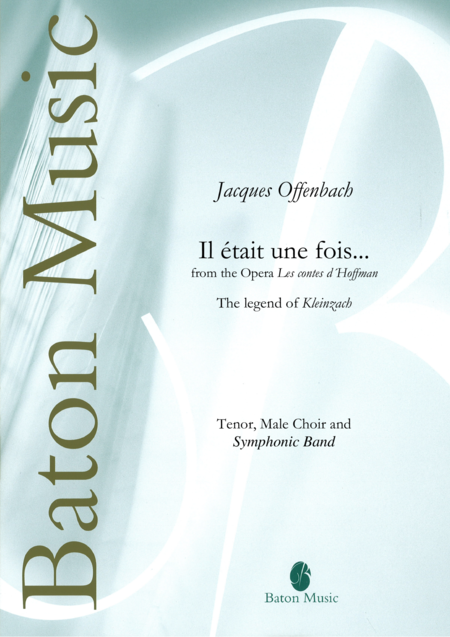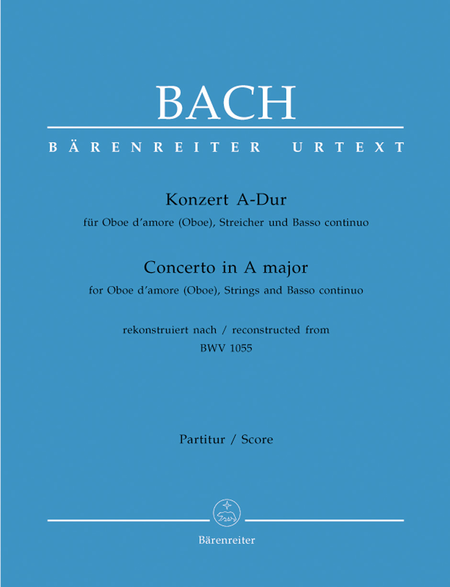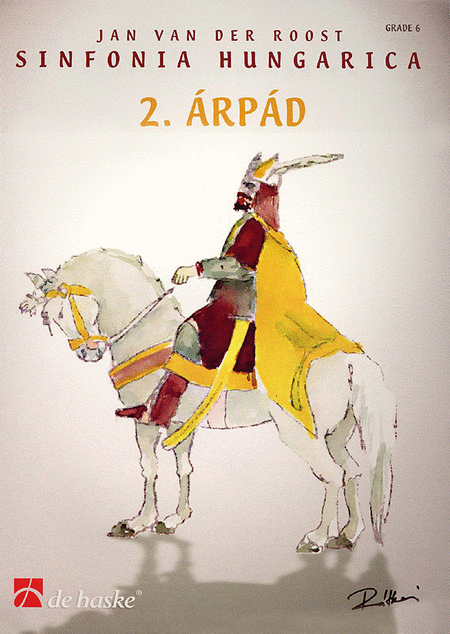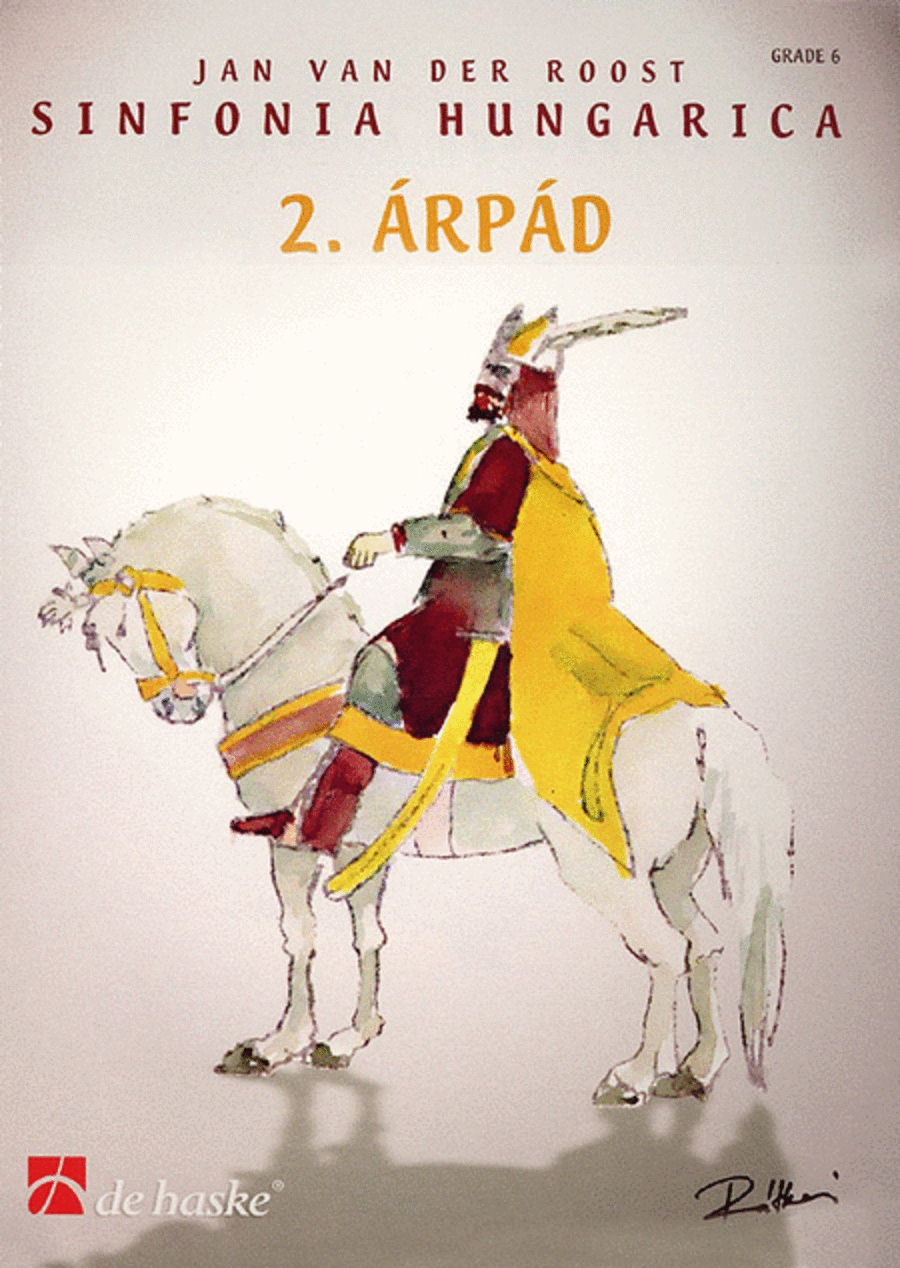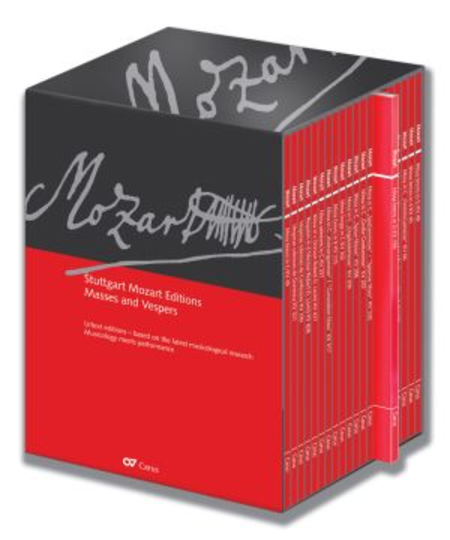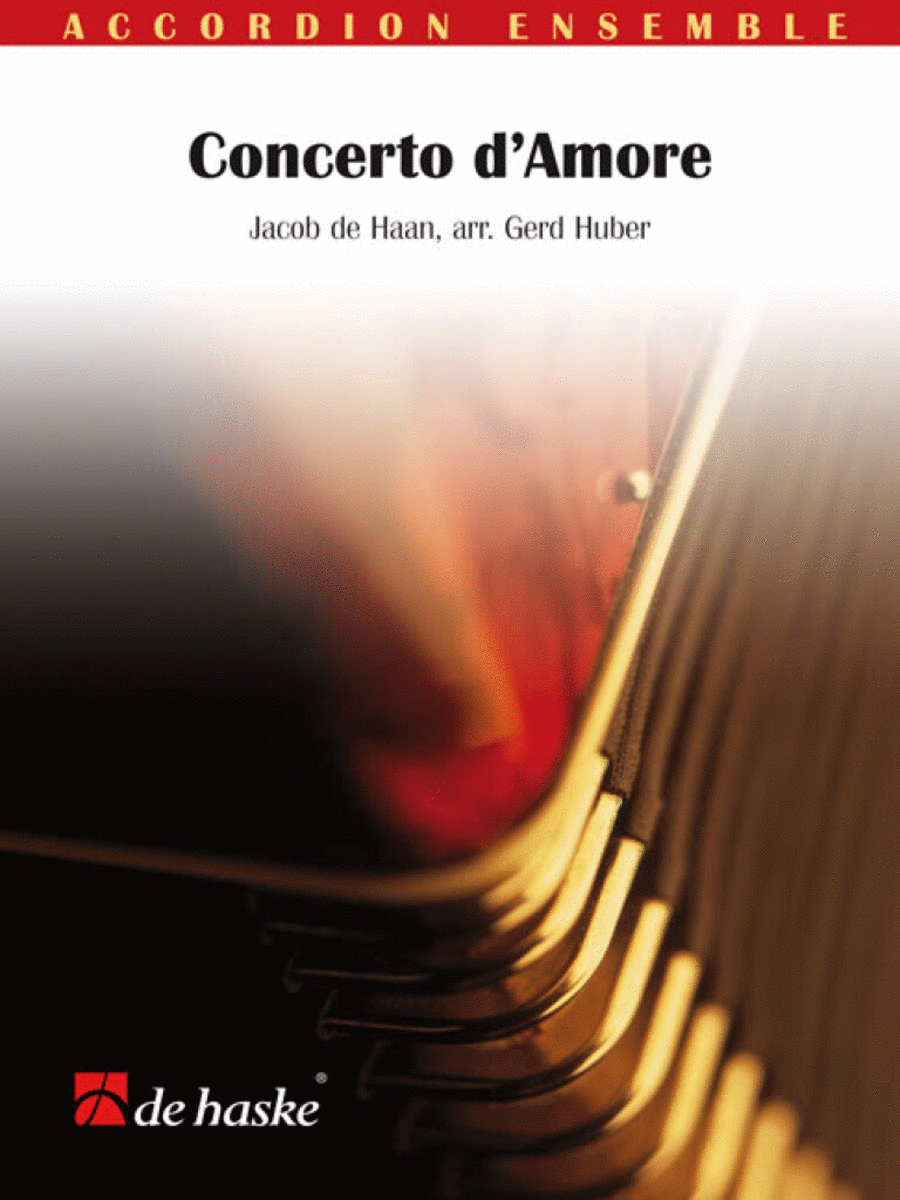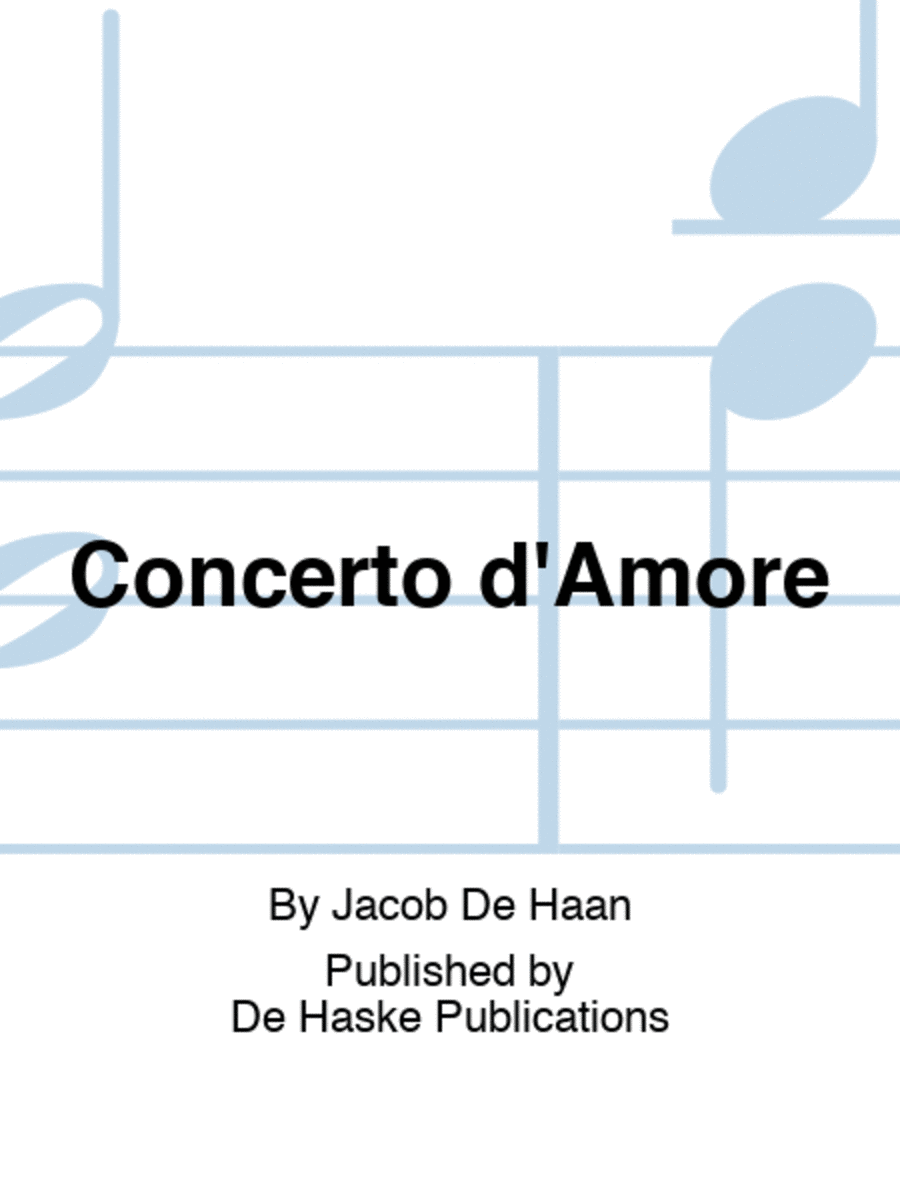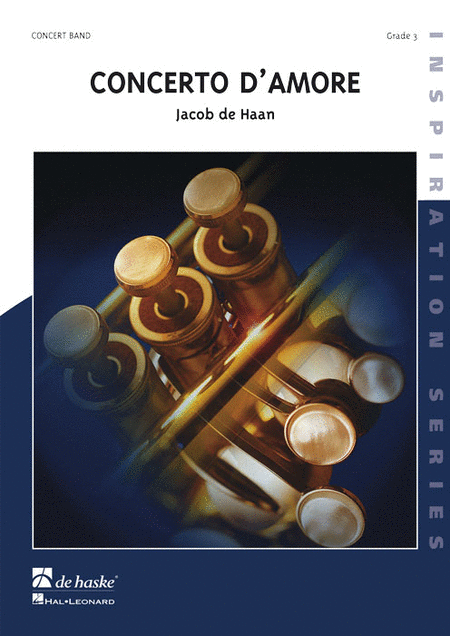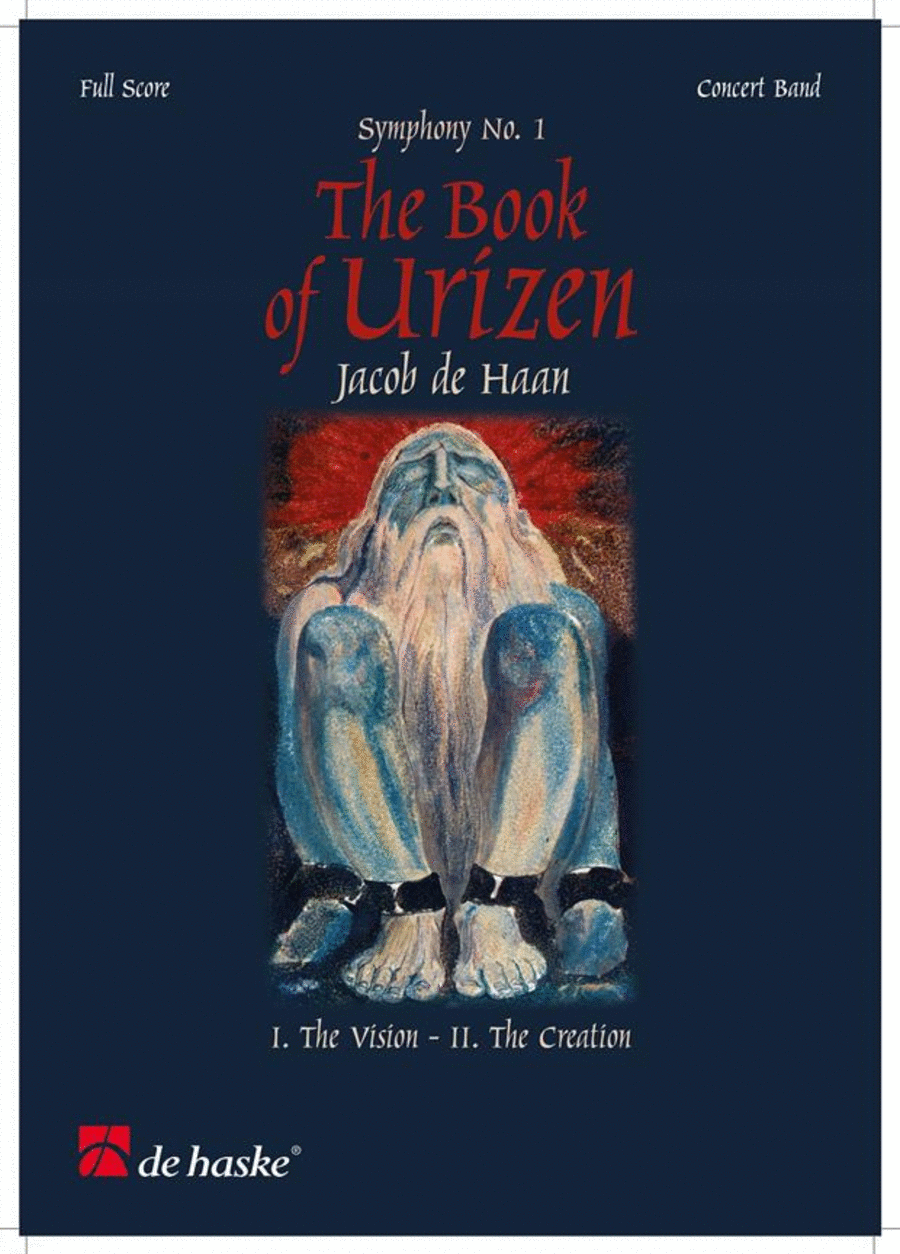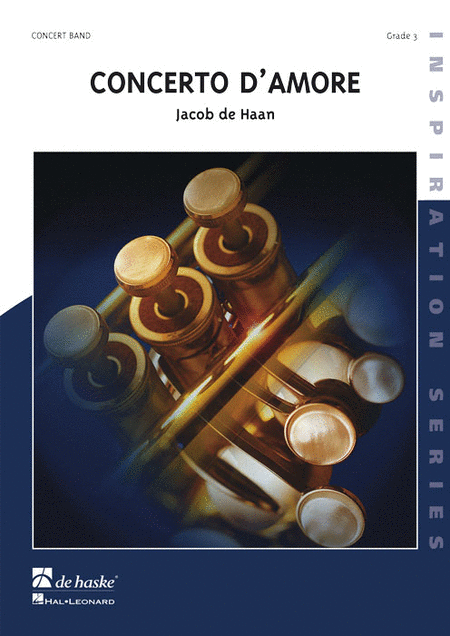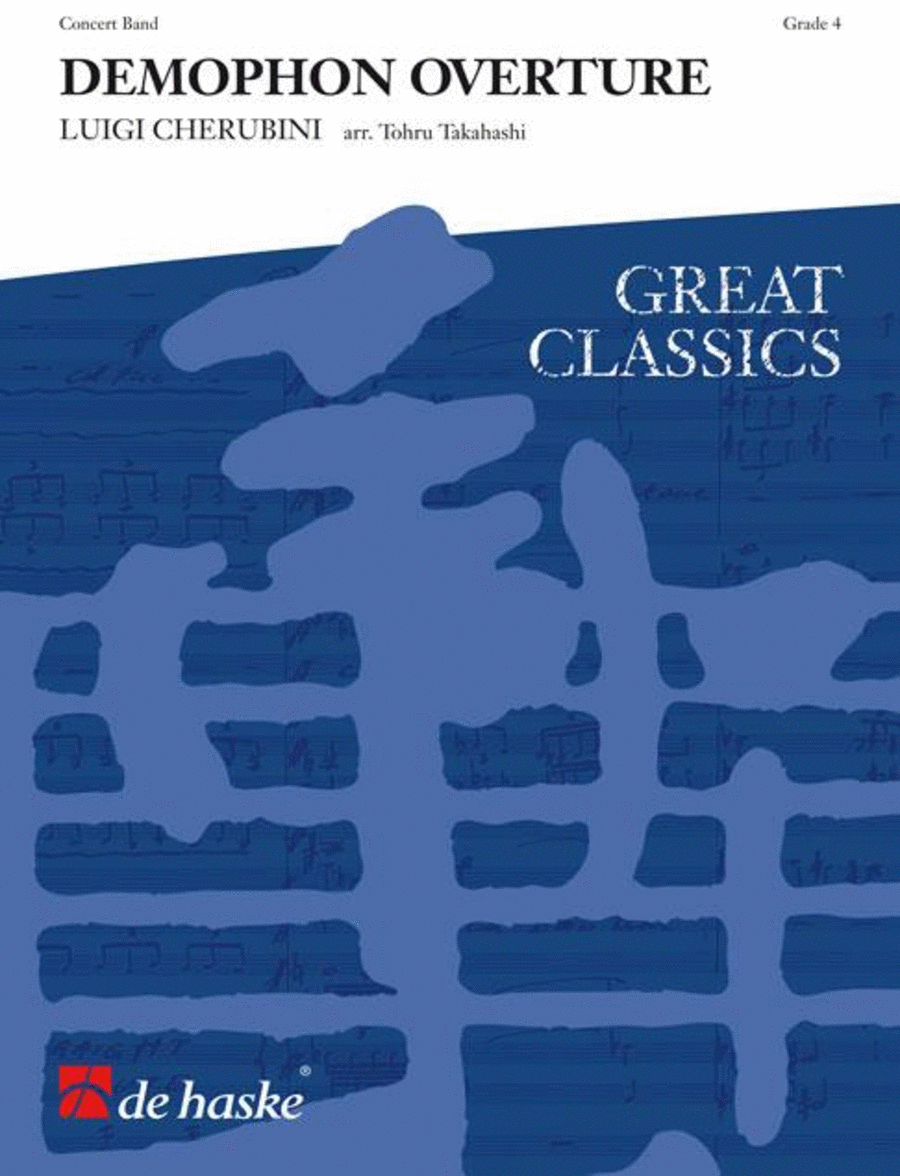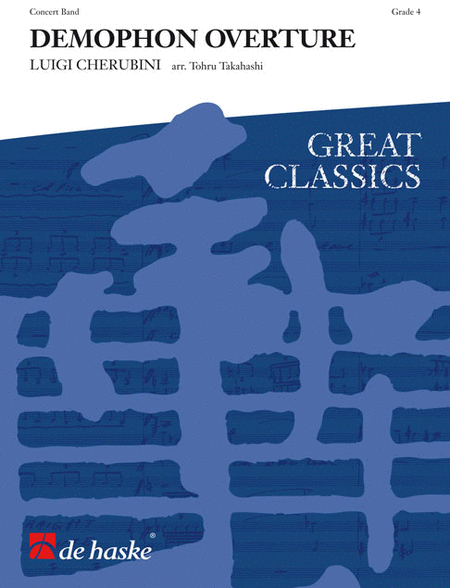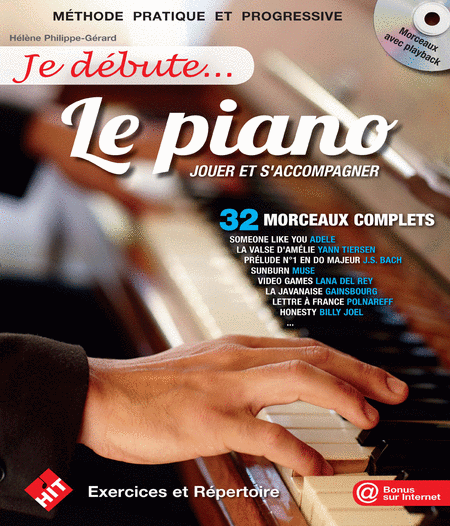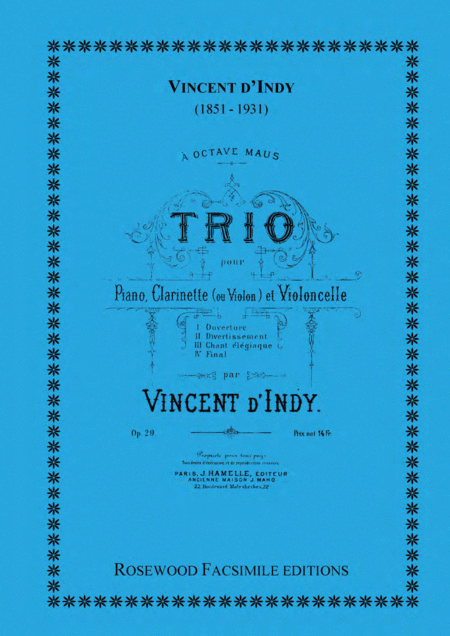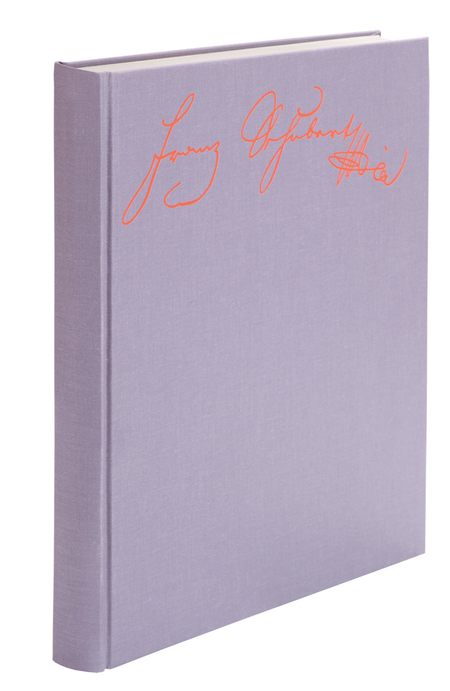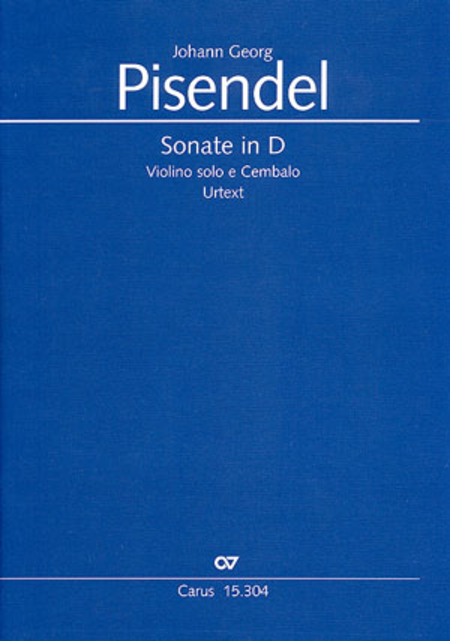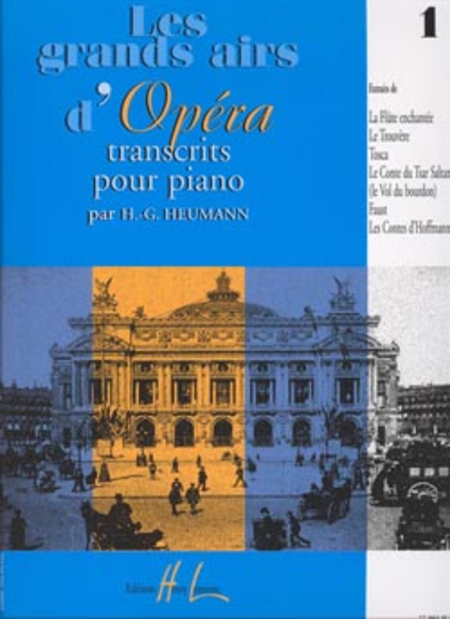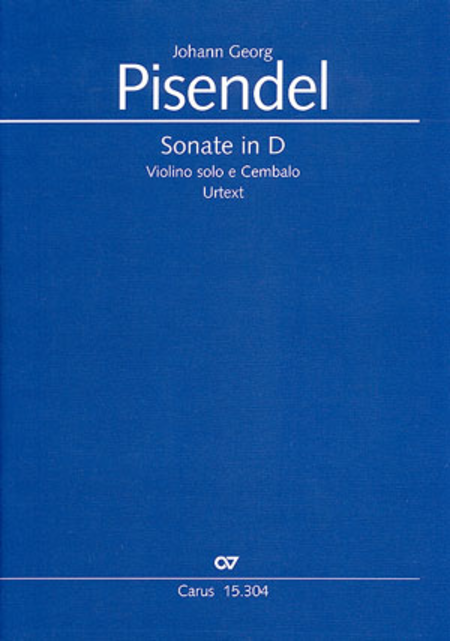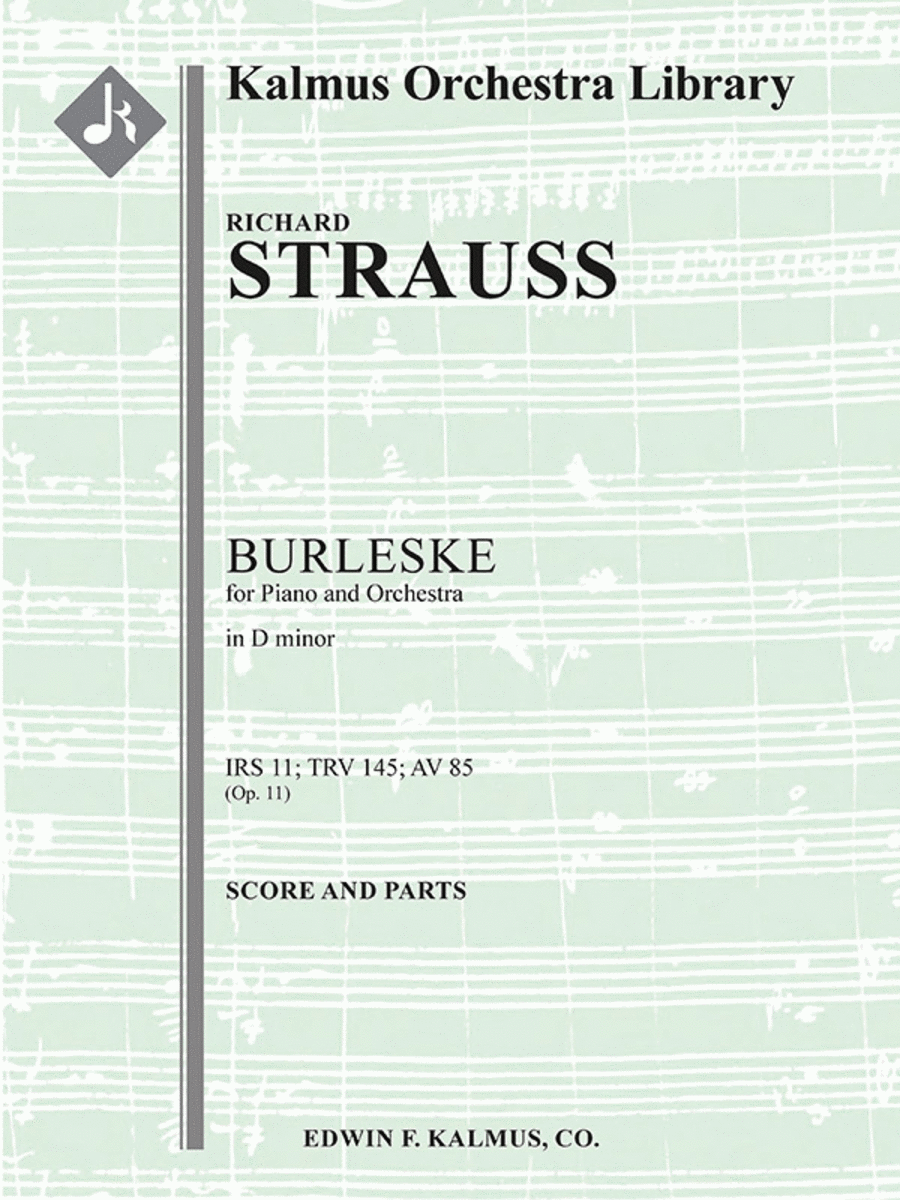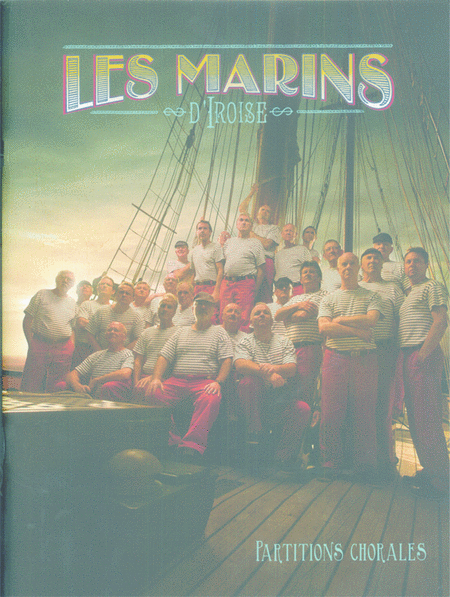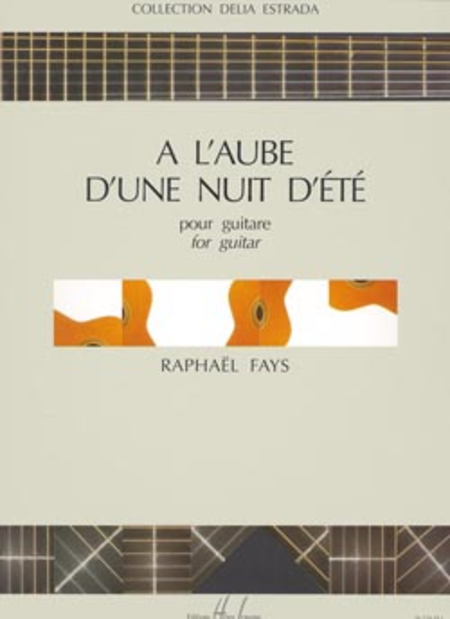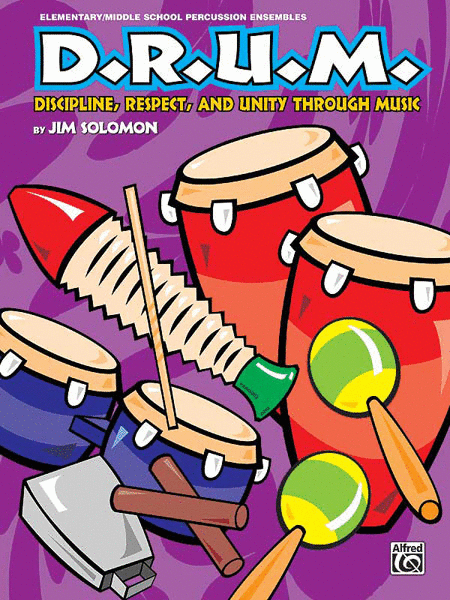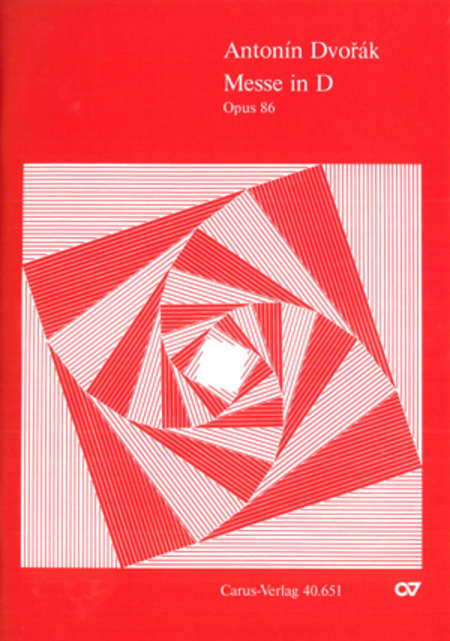|
| Il etait une fois a la cour d'Eisenach
Orchestre d'harmonie, Chorale-Voix [Conducteur] - Intermédiaire
Baton Music
By Jacques Offenbach (1819-1880). Arranged by Andreas van Zoelen. For Tenor Voic...(+)
By Jacques Offenbach
(1819-1880). Arranged by
Andreas van Zoelen. For
Tenor Voice, Male Choir
[ad lib.] and Concert
Band. From the Opera Les
contes d'Hoffman. Grade
3. Full score only.
Duration 5 minutes.
Published by Baton Music
$29.95 - Voir plus => AcheterDélais: 4 to 6 weeks | | | |
| Johann Sebastian Bach: Concerto For Oboe D'Amore In A Major, BWV 1055
Oboe d'amore, violin I, violin II, viola and continuo [Conducteur]
Barenreiter
Composed by Johann Sebastian Bach (1685-1750), edited by Wilfried Fischer. BWV 1...(+)
Composed by Johann
Sebastian Bach
(1685-1750), edited by
Wilfried Fischer. BWV
1055. Full score (parts
not included) for oboe
d'amore, violin I, violin
II, viola and continuo
(cello, bass,
harpsichord). Urtext of
the New Bach Edition. A
Major. 26 pages.
Published by
Baerenreiter-Ausgaben
(German import). ISBN
M006465637.
$39.95 - Voir plus => AcheterDélais: 1 to 2 weeks | | | |
| Arpád (part 2 from 'Sinfonia Hungarica')
Orchestre d'harmonie [Conducteur] - Intermédiaire/avancé
De Haske Publications
Concert Band/Harmonie - Grade 6 SKU: BT.DHP-1002208-140 Composed by Jan V...(+)
Concert Band/Harmonie -
Grade 6 SKU:
BT.DHP-1002208-140
Composed by Jan Van der
Roost. Sovereign Series.
Concert Piece. Score
Only. Composed 2000. 58
pages. De Haske
Publications #DHP
1002208-140. Published by
De Haske Publications
(BT.DHP-1002208-140).
Dit stuk werd
gecomponeerd in opdracht
van het symfonisch
blaasorkest
Kiskunfélegyhaza uit
Hongarije en opgedragen
aan dirigent Ferenc
Jankovski, burgemeester
Jozsef Ficsor en
Gabriella Kiss. De
wereldpremière vond
plaats op 31 maart2001 in
Budapest (Hongarije) door
het eerdergenoemde orkest
onder leiding van de
componist.Deze driedelige
symfonie beschrijft de
geschiedenis van
Hongarije. De drie delen
zijn ge nspireerd op
historische
sleutelfiguren,
oorlogenen andere
belangrijke
gebeurtenissen in dit
land. De symfonie werd
geschreven ter
gelegenheid van de
millenniumviering van
Hongarije in
2001.ATTILA,
koning van de Hunnen,
vaak â??de gesel
Godsâ?? genoemd, is de
centrale figuurin het
eerste deel, dat
voornamelijk wordt
gekenmerkt door angst,
dreiging, agressie en
wreedheid. Attilaâ??s
broer, Buda, heeft echter
een hero scher thema,
terwijl zijn geliefde
vrouw, Rika, een lyrische
melodie heeft. Het
spannendeeinde van dit
openingsdeel illustreert
de gevreesde snelheid van
Attilaâ??s troepen: ze
achtervolgden hun
slachtoffers en
vermoordden ze allemaal!
Het tweede deel gaat over
ARPAD, de stichter
van de Hongaarse staat.
Hetbegint met een
sfeerpassage, die het
beeld oproept van zijn
grootmoeder, Emese,
dromend over zijn
bestemming. Een van
Arpadâ??s tegenstanders,
de Bulgaarse prins Zalan,
werd verdreven na een
gevecht. Hierna noemde
Arpad het gebiedofficieel
â??Magyarorszagâ??.Het
laatste deel is genoemd
naar ISTVAN, de
koning die het
christendom in Hongarije
introduceerde en die werd
gekroond door paus
Silvester II op 1 januari
1001. Een vrij plechtige
start leidt tot nogeen
martiale passage, die
eindigt met een aantal
luide slagen. Deze
symboliseren het voorval
waarbij het lichaam van
de heiden Koppany in vier
stukken werd gesneden,
die naar de vier kastelen
van het land werden
gezonden als
schrikwekkend
Die
Sinfonie in drei
Sätzen ist eine
musikalische Schilderung
der Geschichte Ungarns.
Alle drei Sätze haben
bedeutende historische
Persönlichkeiten und
Schlüsselereignisse
aus der Landesgeschichte
- wie etwa Kriege - zum
Inhalt. Das Werk wurde
zuUngarns
Tausendjahrfeier im Jahr
2001
geschrieben.Attila
, König der Hunnen,
oftmals auch die GeiÃ?el
Gottes genannt, ist die
zentrale Gestalt des
ersten Satzes; in seiner
musikalischen
Beschreibung sind
Aggressivität und
Grausamkeit, die vonihm
ausgehende Bedrohung und
ihm entgegengebrachte
Furcht spürbar.
Daneben erscheinen das
heroischer klingende
Thema von Buda,
Attilas Bruder, und das
lyrische von Rika,
seiner zärtlich
geliebten Frau. Der
aufpeitschende Schluss
desSatzes ist Sinnbild
für die gefürchtete
Schnelligkeit von Attilas
Truppen, mit der sie ihre
Opfer eingeholt und ohne
Ausnahme getötet
haben.Im Mittelpunkt des
zweiten Satzes steht
Arpad, der
eigentliche Begründer
des ungarischen Staates.
Eineatmosphärisch
klingende Einleitung
beschwört
Emese, die
GroÃ?mutter Arpads,
herauf, die im Traum
seine Bestimmung
vorhergesehen hatte. Er
schlug seinen Gegner, den
Prinzen Zalan von
Bulgarien, im Kampf in
die Flucht und gab dem
Land denNamen
Magyarorszag.Das Finale
ist nach Istvan
benannt, dem König,
der in Ungarn das
Christentum einführte
und am ersten Januar 1001
durch Papst Sylvester II.
gekrönt wurde. Ein
feierlicher Anfang leitet
über in einen an
Kriegsgetümmelerinnern
den Abschnitt, der in
lärmendem Getöse
endet. Es steht für
das Ende des Heiden
Koppany, dessen
Körper gevierteilt und
als abschreckendes
Beispiel an die vier
Burgen des Landes gesandt
wurde. Ein ruhiges,
beinahe religiös
wirkendesZwischenspiel
mündet in die
ungarische Nationalhymne.
Dieser prachtvolle, mit
grandioso
überschriebene Schluss
hat auch eine symbolische
Bedeutung: Nach zehn
Jahrhunderten hat Ungarn
guten Grund, mit Stolz
zurückzublicken und
der Zukunft mitZuversicht
und Optimismus
entgegenzusehen.Die
wunderbare Melodie der
Nationalhymne erscheint
in der Sinfonie auch
vorher schon immer
wieder, wird meist aber
ganz oder teilweise
überdeckt. Sie
durchläuft das Werk
wie ein roter Faden, der
anfangs kaumwahrzunehmen
ist und erst im Verlauf
der Sinfonie immer
deutlicher wird. Am Ende
krönt sie das Werk in
einer letzten
prachtvollen Steigerung,
in der das Orchester den
majestätischen Klang
einer Orgel
annimmt.
Sinfon
ia Hungarica est une
?uvre de commande pour
lâ??Orchestre
dâ??Harmonie de
Kiskunfelegyhaze en
Hongrie. Elle est
dédiée Ferenc
Jankovski (Directeur de
lâ??Orchestre
dâ??Harmonie), Jozsef
Ficsor (Maire de la ville
de Kiskunfelegyhaze) et
Gabriella Kiss.Cette
symphonie en trois
mouvements retrace
lâ??histoire de la
Hongrie. Lâ??ensemble
des trois mouvements
sâ??inspire de la vie de
personnages historiques
clés, de guerres et
dâ??autres
événements de
grande importance qui ont
marqué lâ??histoire
de ce pays. Sinfonia
Hungarica
célèbre le
millénaire de la
fondation de lâ??�tat
hongrois (1001-2001).
Lâ???uvre a été
donnée en création
mondiale, le 31 mars 2001
Budapest,par
lâ??Orchestre
dâ??Harmonie de
Kiskunfelegyhaze placé
sous la direction du
compositeur.ATTILA
, roi des Huns,
surnommé â??le
Fléau de Dieuâ?Â,
est le personnage central
du premier mouvement
où règne une
atmosphère de peur, de
menace, dâ??agression et
de cruauté. Bléda,
le frère dâ??Attila,
est associé un
thème aux accents plus
héro ques, tandis que
Kerka, lâ??épouse
bien-aimée du roi des
Huns, est
représentée par une
mélodie lyrique. La
fin trépidante de ce
mouvement dâ??ouverture
illustre lâ??effroyable
rapidité avec laquelle
les troupes dâ??Attila
poursuivaient et tuaient
toutes leurs victimes.Le
deuxième mouvement est
centré sur
ARPAD, le
fondateur de lâ??�tat
hongrois. Un passage
limpide et aérien
ouvre ce mouvement
évoquant �mèse,
la grand-mère
dâ??Arpad, qui vit en
rêve sa destinée
future. Après avoir
livré bataille contre
lâ??un de ses opposants,
le prince bulgare Zalan,
et lâ??avoir chassé
des terres magyares,
Arpad donne
officiellement au
territoire le nom de
Magyarorszag.Le
troisième et dernier
mouvement de la symphonie
porte le nom de celui qui
convertit le pays au
christianisme : Ã?tienne
Ier (ISTVAN),
sacré roi de Hongrie
le 1er janvier 1001 par
le Pape Sylvestre II. Les
mesures dâ??ouverture,
solennelles et
majestueuses, mènent
un passage dont
lâ??atmosphère
belliqueuse
sâ??intensifie pour
sâ??achever en de
violents fracas
symbolisant la mort
Sinfonia
Hungarica,
commissionata dalla banda
ungherese di
Kiskunfelegyahaza, è
dedicata al maestro
Ferenc Jankovski, al
sindaco della citt Jozsef
Ficsor e a Gabriella
Kiss. La prima mondiale,
eseguita dalla banda
Kiskunfelegyhaza si è
tenutaa Budapest il 31
marzo 2001 sotto la
direzione del
compositore.Gli eventi
salienti della storia
dellâ??Ungheria, come le
guerre ed altri
avvenimenti importanti,
sono tradotti in musica
in questa sinfonia
strutturata in tre
movimenti. Sinfonia
Hungaricavuole anche
essere un omaggio allo
stato ungherese che
festeggia il suo
millennio nel
2001.ATTILA, re
degli Unni, spesso
chiamato â??il flagello
di Dioâ?? è la figura
centrale del primo
movimento, caratterizzato
dalla paura, dalla
minaccia,dallâ??aggressi
one e dalla crudelt .
Buda, fratello di Attila
è associato ad un tema
più eroico, mentre
Rika, lâ??amata moglie,
è rappresentata da una
melodia lirica.
Lâ??eccitante finale di
questo movimento di
apertura illustra la
tanto temuta velocit
delle truppe di Attila
che seminavano paura e
morte.Il secondo
movimento pone
lâ??accento su
ARPAD, il
fondatore dello Stato
ungherese. Inizia con un
passaggio in stile
atmosferico che evoca la
nonna di Arpad, Emese che
aveva sognato e
predettoil futuro del
nipote. Uno degli
oppositori di Arpad, il
principe bulgaro Zalan,
fu cacciato dopo una
battaglia. In seguito,
Arpad chiamò
ufficialmente il
territorio
â??Magyarorszagâ?Â.Il
movimento finale prende
il nome da ISTVAN,
il re che portòil
cristianesimo in Ungheria
e che fu incoronato da
Papa Silvestro II il 1
gennaio, 1001. Un inizio
solenne prelude ad un
passaggio bellico
accentuato da rumori
imponenti; questo a
simboleggiare lâ??atroce
fine del pagano Koppany
il cui corpo futagliato
in quattro pezzi e
inviato ai quattro
castelli del paese come
monito. Dopo un
intermezzo quieto, quasi
religioso, viene
presentato lâ??Inno
nazionale ungherese. In
questo ampio e grandioso
finale riecheggia
lâ??orgoglio
dellâ??Ungheria
nelricordare il suo
passato e la fiducia con
la quale si proietta al
futuro.Lo stupendo tema
dellâ??Inno nazionale
ungherese è proposto
nellâ??arco
dellâ??intera sinfonia.
Eâ?? però spesso
parzialmente nascosto e
usato come filo
conduttore, appena
riconoscibileallâ??inizi
o ma sempre più ovvio
quando la sinfonia si
avvicina al suo finale. A
conclusione della
sinfonia, il sublime inno
conduce la banda in
unâ??apoteosi finale,
facendo apparire
lâ??organico strumentale
come un maestoso
organo. $62.95 - Voir plus => AcheterDélais: 2 to 3 weeks | | | |
| Arpád (part 2 from 'Sinfonia Hungarica')
Orchestre d'harmonie [Conducteur et Parties séparées] - Intermédiaire/avancé
De Haske Publications
Concert Band/Harmonie - Grade 6 SKU: BT.DHP-1002208-010 Composed by Jan V...(+)
Concert Band/Harmonie -
Grade 6 SKU:
BT.DHP-1002208-010
Composed by Jan Van der
Roost. Sovereign Series.
Concert Piece. Set (Score
& Parts). Composed 2000.
De Haske Publications
#DHP 1002208-010.
Published by De Haske
Publications
(BT.DHP-1002208-010).
Sinfonia
Hungarica is a
three-movement symphony
that depicts the history
of Hungary. All three
movements were inspired
by historical key
figures, wars, and other
important events from
this country. This
symphony is a celebration
of Hungaryââ¬â¢s
millennium in 2001.The
second movement focuses
on ARPAD, the actual
founder of the Hungarian
State. It starts with an
atmospherical passage,
evoking his grandmother,
Emese, who dreamt about
his future destination.
One of Arpadââ¬â¢s
opponents, the Bulgarian
Prince Zalan, was chased
away after a fight. After
this, Arpad officially
named the territory
ââ¬ÅMagyarorszag.ââ¬
Â
Dit stuk werd
gecomponeerd in opdracht
van het symfonisch
blaasorkest
Kiskunfélegyhaza uit
Hongarije en opgedragen
aan dirigent Ferenc
Jankovski, burgemeester
Jozsef Ficsor en
Gabriella Kiss. De
wereldpremière vond
plaats op 31 maart2001 in
Budapest (Hongarije) door
het eerdergenoemde orkest
onder leiding van de
componist.Deze driedelige
symfonie beschrijft de
geschiedenis van
Hongarije. De drie delen
zijn ge nspireerd op
historische
sleutelfiguren,
oorlogenen andere
belangrijke
gebeurtenissen in dit
land. De symfonie werd
geschreven ter
gelegenheid van de
millenniumviering van
Hongarije in
2001.ATTILA,
koning van de Hunnen,
vaak ââ¬Ëde gesel
Godsââ¬â¢ genoemd, is
de centrale figuurin het
eerste deel, dat
voornamelijk wordt
gekenmerkt door angst,
dreiging, agressie en
wreedheid.
Attilaââ¬â¢s broer,
Buda, heeft echter een
hero scher thema, terwijl
zijn geliefde vrouw,
Rika, een lyrische
melodie heeft. Het
spannendeeinde van dit
openingsdeel illustreert
de gevreesde snelheid van
Attilaââ¬â¢s troepen:
ze achtervolgden hun
slachtoffers en
vermoordden ze allemaal!
Het tweede deel gaat over
ARPAD, de stichter
van de Hongaarse staat.
Hetbegint met een
sfeerpassage, die het
beeld oproept van zijn
grootmoeder, Emese,
dromend over zijn
bestemming. Een van
Arpadââ¬â¢s
tegenstanders, de
Bulgaarse prins Zalan,
werd verdreven na een
gevecht. Hierna noemde
Arpad het gebiedofficieel
ââ¬ËMagyarorszagââ¬â
¢.Het laatste deel is
genoemd naar
ISTVAN, de koning
die het christendom in
Hongarije introduceerde
en die werd gekroond door
paus Silvester II op 1
januari 1001. Een vrij
plechtige start leidt tot
nogeen martiale passage,
die eindigt met een
aantal luide slagen. Deze
symboliseren het voorval
waarbij het lichaam van
de heiden Koppany in vier
stukken werd gesneden,
die naar de vier kastelen
van het land werden
gezonden als
schrikwekkend
Die
Sinfonie in drei
Sätzen ist eine
musikalische Schilderung
der Geschichte Ungarns.
Alle drei Sätze haben
bedeutende historische
Persönlichkeiten und
Schlüsselereignisse
aus der Landesgeschichte
- wie etwa Kriege - zum
Inhalt. Das Werk wurde
zuUngarns
Tausendjahrfeier im Jahr
2001
geschrieben.Attila
, König der Hunnen,
oftmals auch die
Geißel Gottes genannt,
ist die zentrale Gestalt
des ersten Satzes; in
seiner musikalischen
Beschreibung sind
Aggressivität und
Grausamkeit, die vonihm
ausgehende Bedrohung und
ihm entgegengebrachte
Furcht spürbar.
Daneben erscheinen das
heroischer klingende
Thema von Buda,
Attilas Bruder, und das
lyrische von Rika,
seiner zärtlich
geliebten Frau. Der
aufpeitschende Schluss
desSatzes ist Sinnbild
für die gefürchtete
Schnelligkeit von Attilas
Truppen, mit der sie ihre
Opfer eingeholt und ohne
Ausnahme getötet
haben.Im Mittelpunkt des
zweiten Satzes steht
Arpad, der
eigentliche Begründer
des ungarischen Staates.
Eineatmosphärisch
klingende Einleitung
beschwört
Emese, die
Großmutter Arpads,
herauf, die im Traum
seine Bestimmung
vorhergesehen hatte. Er
schlug seinen Gegner, den
Prinzen Zalan von
Bulgarien, im Kampf in
die Flucht und gab dem
Land denNamen
Magyarorszag.Das Finale
ist nach Istvan
benannt, dem König,
der in Ungarn das
Christentum einführte
und am ersten Januar 1001
durch Papst Sylvester II.
gekrönt wurde. Ein
feierlicher Anfang leitet
über in einen an
Kriegsgetümmelerinnern
den Abschnitt, der in
lärmendem Getöse
endet. Es steht für
das Ende des Heiden
Koppany, dessen
Körper gevierteilt und
als abschreckendes
Beispiel an die vier
Burgen des Landes gesandt
wurde. Ein ruhiges,
beinahe religiös
wirkendesZwischenspiel
mündet in die
ungarische Nationalhymne.
Dieser prachtvolle, mit
grandioso
überschriebene Schluss
hat auch eine symbolische
Bedeutung: Nach zehn
Jahrhunderten hat Ungarn
guten Grund, mit Stolz
zurückzublicken und
der Zukunft mitZuversicht
und Optimismus
entgegenzusehen.Die
wunderbare Melodie der
Nationalhymne erscheint
in der Sinfonie auch
vorher schon immer
wieder, wird meist aber
ganz oder teilweise
überdeckt. Sie
durchläuft das Werk
wie ein roter Faden, der
anfangs kaumwahrzunehmen
ist und erst im Verlauf
der Sinfonie immer
deutlicher wird. Am Ende
krönt sie das Werk in
einer letzten
prachtvollen Steigerung,
in der das Orchester den
majestätischen Klang
einer Orgel
annimmt.
Sinfon
ia Hungarica est une
œuvre de commande
pour lââ¬â¢Orchestre
dââ¬â¢Harmonie de
Kiskunfelegyhaze en
Hongrie. Elle est
dédiée Ferenc
Jankovski (Directeur de
lââ¬â¢Orchestre
dââ¬â¢Harmonie),
Jozsef Ficsor (Maire de
la ville de
Kiskunfelegyhaze) et
Gabriella Kiss.Cette
symphonie en trois
mouvements retrace
lââ¬â¢histoire de la
Hongrie.
Lââ¬â¢ensemble des
trois mouvements
sââ¬â¢inspire de la
vie de personnages
historiques clés, de
guerres et
dââ¬â¢autres
événements de
grande importance qui ont
marqué
lââ¬â¢histoire de ce
pays. Sinfonia
Hungarica
célèbre le
millénaire de la
fondation de
lââ¬â¢Ãâ°tat
hongrois (1001-2001).
Lââ¬â¢œuvre a
été donnée en
création mondiale, le
31 mars 2001 Budapest,par
lââ¬â¢Orchestre
dââ¬â¢Harmonie de
Kiskunfelegyhaze placé
sous la direction du
compositeur.ATTILA
, roi des Huns,
surnommé ââ¬Åle
Fléau de Dieuââ¬Â,
est le personnage central
du premier mouvement
où règne une
atmosphère de peur, de
menace,
dââ¬â¢agression et de
cruauté. Bléda, le
frère dââ¬â¢Attila,
est associé un
thème aux accents plus
héro ques, tandis que
Kerka, lââ¬â¢Ã©pouse
bien-aimée du roi des
Huns, est
représentée par une
mélodie lyrique. La
fin trépidante de ce
mouvement
dââ¬â¢ouverture
illustre
lââ¬â¢effroyable
rapidité avec laquelle
les troupes
dââ¬â¢Attila
poursuivaient et tuaient
toutes leurs victimes.Le
deuxième mouvement est
centré sur
ARPAD, le
fondateur de
lââ¬â¢Ãâ°tat
hongrois. Un passage
limpide et aérien
ouvre ce mouvement
évoquant Ãâ°mèse,
la grand-mère
dââ¬â¢Arpad, qui vit
en rêve sa destinée
future. Après avoir
livré bataille contre
lââ¬â¢un de ses
opposants, le prince
bulgare Zalan, et
lââ¬â¢avoir chassé
des terres magyares,
Arpad donne
officiellement au
territoire le nom de
Magyarorszag.Le
troisième et dernier
mouvement de la symphonie
porte le nom de celui qui
convertit le pays au
christianisme :
Ãâ°tienne Ier
(ISTVAN), sacré
roi de Hongrie le 1er
janvier 1001 par le Pape
Sylvestre II. Les mesures
dââ¬â¢ouverture,
solennelles et
majestueuses, mènent
un passage dont
lââ¬â¢atmosphère
belliqueuse
sââ¬â¢intensifie pour
sââ¬â¢achever en de
violents fracas
symbolisant la mort
Sinfonia
Hungarica,
commissionata dalla banda
ungherese di
Kiskunfelegyahaza, è
dedicata al maestro
Ferenc Jankovski, al
sindaco della citt Jozsef
Ficsor e a Gabriella
Kiss. La prima mondiale,
eseguita dalla banda
Kiskunfelegyhaza si è
tenutaa Budapest il 31
marzo 2001 sotto la
direzione del
compositore.Gli eventi
salienti della storia
dellââ¬â¢Ungheria,
come le guerre ed altri
avvenimenti importanti,
sono tradotti in musica
in questa sinfonia
strutturata in tre
movimenti. Sinfonia
Hungaricavuole anche
essere un omaggio allo
stato ungherese che
festeggia il suo
millennio nel
2001.ATTILA, re
degli Unni, spesso
chiamato ââ¬Åil
flagello di Dioââ¬Å
è la figura centrale
del primo movimento,
caratterizzato dalla
paura, dalla
minaccia,dallââ¬â¢aggr
essione e dalla crudelt .
Buda, fratello di Attila
è associato ad un tema
più eroico, mentre
Rika, lââ¬â¢amata
moglie, è
rappresentata da una
melodia lirica.
Lââ¬â¢eccitante finale
di questo movimento di
apertura illustra la
tanto temuta velocit
delle truppe di Attila
che seminavano paura e
morte.Il secondo
movimento pone
lââ¬â¢accento su
ARPAD, il
fondatore dello Stato
ungherese. Inizia con un
passaggio in stile
atmosferico che evoca la
nonna di Arpad, Emese che
aveva sognato e
predettoil futuro del
nipote. Uno degli
oppositori di Arpad, il
principe bulgaro Zalan,
fu cacciato dopo una
battaglia. In seguito,
Arpad chiamò
ufficialmente il
territorio
ââ¬ÅMagyarorszagââ¬Â
.Il movimento finale
prende il nome da
ISTVAN, il re che
portòil cristianesimo
in Ungheria e che fu
incoronato da Papa
Silvestro II il 1
gennaio, 1001. Un inizio
solenne prelude ad un
passaggio bellico
accentuato da rumori
imponenti; questo a
simboleggiare
lââ¬â¢atroce fine del
pagano Koppany il cui
corpo futagliato in
quattro pezzi e inviato
ai quattro castelli del
paese come monito. Dopo
un intermezzo quieto,
quasi religioso, viene
presentato lââ¬â¢Inno
nazionale ungherese. In
questo ampio e grandioso
finale riecheggia
lââ¬â¢orgoglio
dellââ¬â¢Ungheria
nelricordare il suo
passato e la fiducia con
la quale si proietta al
futuro.Lo stupendo tema
dellââ¬â¢Inno
nazionale ungherese è
proposto nellââ¬â¢arco
dellââ¬â¢intera
sinfonia. Eââ¬â¢
però spesso
parzialmente nascosto e
usato come filo
conduttore, appena
riconoscibileallââ¬â¢i
nizio ma sempre più
ovvio quando la sinfonia
si avvicina al suo
finale. A conclusione
della sinfonia, il
sublime inno conduce la
banda in
unââ¬â¢apoteosi
finale, facendo apparire
lââ¬â¢organico
strumentale come un
maestoso organo. $314.95 - Voir plus => AcheterDélais: 4 to 6 weeks | | | |
| All Masses and Vespers as Study scores
Orchestre d'harmonie, Chorale-Voix [Conducteur]
Carus Verlag
Composed by Robert D. Levin / Wolfgang Amadeus Mozart. Stuttgart Urtext Edition....(+)
Composed by Robert D.
Levin / Wolfgang Amadeus
Mozart. Stuttgart Urtext
Edition. German title:
Messen (18), Requiem, 2
Vespern /Schuber. Latin
Masses, Missa brevis in
Latin, Requiem. Set with
study scores. Published
by Carus Verlag
$172.95 - Voir plus => AcheterDélais: 2 to 3 weeks | | | |
| Concerto d'Amore
Ensemble d'Accordéons [Conducteur et Parties séparées] - Facile
De Haske Publications
Accordion Orchestra - Grade 3 SKU: BT.DHP-1043385-060 Composed by Jacob D...(+)
Accordion Orchestra -
Grade 3 SKU:
BT.DHP-1043385-060
Composed by Jacob De
Haan. Arranged by Gerd
Huber. Accordion.
Educational Tool. Set
(Score & Parts). Composed
2004. 24 pages. De Haske
Publications #DHP
1043385-060. Published by
De Haske Publications
(BT.DHP-1043385-060).
ISBN 9789043119290.
International. In
Concerto dââ¬â¢Amore,
a maestoso opening is
followed by a quick and
energetic movement that
leads to a magnificent
adagio. A motif from this
adagio can be heard in a
swinging movement, after
which the piece comes to
a close with the return
of the adagio. This
arrangement by Gerd Huber
makes it possible for
each accordion ensemble
to bring this beautiful
music to life.
In
Concerto
dââ¬â¢Amore volgt
na een maestoso inleiding
een snel en energiek
gedeelte, dat uitmondt in
een schitterend adagio.
Een motief daaruit is
vervolgens verwerkt in
een swingend gedeelte,
waarna het stuk besluit
met de terugkeervan het
adagio. Dit arrangement
van de hand van Gerd
Huber stelt elk
accordeonensemble in de
gelegenheid deze mooie
muziek tot leven te
brengen.
In
Concerto
dââ¬â¢Amore folgt
auf ein Maestoso als
Einleitung ein schneller,
energiereicher Satz, der
zu einem bezaubernden
Adagio führt. Ein
Motiv dieses Adagios
erklingt in einem
schwungvollen Satz, nach
welchem das Stück mit
der Rückkehr des
Adagios endet. Mit der
Bearbeitung von Gerd
Huber kann jedes
Akkordeonensemble diese
schöne Musik von Jacob
de Haan zum Leben
erwecken.
Concerto
dââ¬â¢Amore
débute avec une
introduction majestueuse
qui chemine vers un
passage vif et
énergique.
Lââ¬â¢adagio
qui lui succède
développe un motif
mélodieux que
lââ¬â¢on retrouve dans
un passage aux inflexions
de swing. Concerto
dââ¬â¢Amore se
conclut par un ultime
retour du motif de
lââ¬â¢adagio,
conclusion brillante
dââ¬â¢une œuvre
richement colorée.
Lââ¬â¢arrangement pour
Orchestre
dââ¬â¢Accordéons,
réalisé par Gerd
Huber, reste fidèle la
beauté de la version
originale. $72.95 - Voir plus => AcheterDélais: 2 to 3 weeks | | | |
| Concerto d'Amore
Orchestre d'harmonie [Conducteur] - Facile
De Haske Publications
Concert Band/Harmonie/Fanfare Band - Grade 3 SKU: BT.DHP-0950624-215 Comp...(+)
Concert
Band/Harmonie/Fanfare
Band - Grade 3 SKU:
BT.DHP-0950624-215
Composed by Jacob De
Haan. Inspiration Series.
Original Light Music.
Score Only. Composed
1995. 28 pages. De Haske
Publications #DHP
0950624-215. Published by
De Haske Publications
(BT.DHP-0950624-215).
9x12 inches. In
Concerto dââ¬â¢Amore,
a maestoso opening is
followed by a quick and
energetic movement that
leads to a magnificent
adagio. A motif from this
adagio can be heard in a
swinging movement, after
which the piece comes to
a close with the return
of the adagio. This
arrangement for concert
band certainly brings
this beautiful music to
life.
In
Concerto
dââ¬â¢Amore worden
drie verschillende
stijlen gecombineerd:
barok, pop en jazz. De
maestoso introductie van
de compositie klinkt als
een barokouverture. Dan
volgt een energiek
gedeelte in popstijl, dat
uitmondt in eenadagio.
Een motief daaruit is
daarna te horen in een
swingende passage, waarna
het werk besluit met de
terugkeer van het adagio
in een nieuw
jasje.
Concerto
dââ¬â¢Amore
vereinigt drei
unterschiedliche Stile:
Barock, Pop und Jazz. Die
Maestoso bezeichnete
Einleitung der
Komposition klingt wie
eine barocke
Ouvertüre. Es folgt
ein energiereicher
Abschnitt im Pop-Stil,
der wiederum zu einem
Adagio führt. Ein
Motiv aus diesem Adagio
ist in der darauf
folgenden Swing-Passage
zu hören. Dann kehrt
Adagio in neuem Gewand
zurück, um das Werk zu
beenden.
Concerto
dââ¬â¢Amore est
composé de trois
périodes
thématiques aux
caractéristiques de la
musique baroque, pop et
jazz.
Lââ¬â¢introduction
majestueuse, aux allures
dââ¬â¢ouverture
baroque, chemine vers un
passage vif et
énergique écrit
dans le style de la
musique pop.
Lââ¬â¢adagio qui lui
succède progresse vers
un passage aux inflexions
de swing. Concerto
dââ¬â¢Amore se
conclut par la reprise du
motif de lââ¬â¢adagio
dont la forme
altérée offre une
conclusion brillante
cette œuvre
richement
colorée.
Con
certo dââ¬â¢Amore
si compone di tre periodi
tematici con
caratteristiche della
musica barocca, pop e
jazz. La maestosa
introduzione, dagli
accenti barocchi,
accompagna ad un
passaggio vivo ed
energico scritto nello
stile della musica pop.
Segue lââ¬â¢adagio che
sviluppa un passaggio
dalle inflessioni swing.
Concerto dââ¬â¢Amore
si conclude con la
ripresa del motivo
dellââ¬â¢adagio la cui
forma alterata offre una
conclusione
brillante. $23.95 - Voir plus => AcheterDélais: 2 to 3 weeks | | | |
| Concerto d'Amore
Orchestre d'harmonie [Conducteur] - Facile
De Haske Publications
Concert Band/Harmonie - Grade 3 SKU: BT.DHP-0950624-140 Composed by Jacob...(+)
Concert Band/Harmonie -
Grade 3 SKU:
BT.DHP-0950624-140
Composed by Jacob De
Haan. Inspiration Series.
Concert Piece. Score
Only. Composed 2006. 36
pages. De Haske
Publications #DHP
0950624-140. Published by
De Haske Publications
(BT.DHP-0950624-140).
9x12 inches.
English-German-French-Dut
ch. In Concerto
dâ≢Amore, a
maestoso opening is
followed by a quick and
energetic movement that
leads to a magnificent
adagio. A motif from this
adagio can be heard in a
swinging movement, after
which the piece comes to
a close with the return
of the adagio. This
arrangement for concert
band certainly brings
this beautiful music to
life.
In
Concerto
dâ≢Amore worden drie
verschillende stijlen
gecombineerd: barok, pop
en jazz. De maestoso
introductie van de
compositie klinkt als een
barokouverture. Dan volgt
een energiek gedeelte in
popstijl, dat uitmondt in
eenadagio. Een motief
daaruit is daarna te
horen in een swingende
passage, waarna het werk
besluit met de terugkeer
van het adagio in een
nieuw
jasje.
Concerto
dâ≢Amore vereinigt drei
unterschiedliche Stile:
Barock, Pop und Jazz. Die
Maestoso bezeichnete
Einleitung der
Komposition klingt wie
eine barocke
OuvertÃÂüre. Es
folgt ein energiereicher
Abschnitt im Pop-Stil,
der wiederum zu einem
Adagio fÃÂührt. Ein
Motiv aus diesem Adagio
ist in der darauf
folgenden Swing-Passage
zu hÃÂören. Dann
kehrt Adagio in neuem
Gewand zurÃÂück, um
das Werk zu beenden.
Concerto
dâ≢Amore est composÃÂé de
trois pÃÂériodes
thÃÂématiques aux
caractÃÂéristiques
de la musique baroque,
pop et jazz.
Lâ≢introduc
tion majestueuse, aux
allures
dâ≢ouvertur
e baroque, chemine vers
un passage vif et
ÃÂénergique
ÃÂécrit dans le
style de la musique pop.
Lâ≢adagio
qui lui succÃÂède
progresse vers un passage
aux inflexions de swing.
Concerto
dâ≢Amore se conclut par la
reprise du motif de
lâ≢adagio
dont la forme
altÃÂérÃÂée
offre une conclusion
brillante cette Ã
Âuvre
richement
colorÃÂée.
Concerto
dâ≢Amore si compone di tre
periodi tematici con
caratteristiche della
musica barocca, pop e
jazz. La maestosa
introduzione, dagli
accenti barocchi,
accompagna ad un
passaggio vivo ed
energico scritto nello
stile della musica pop.
Segue
lâ≢adagio
che sviluppa un passaggio
dalle inflessioni swing.
Concerto
dâ≢Amore si conclude con la
ripresa del motivo
dellâ≢adagi
o la cui forma alterata
offre una conclusione
brillante. $29.95 - Voir plus => AcheterDélais: 24 hours - In Stock | | | |
| The Book of Urizen - Symphony No. 1 (CD incl.)
Orchestre d'harmonie [Conducteur et Parties séparées + CD] - Intermédiaire
De Haske Publications
The Book of Urizen is Jacob de Haan his first Symphony for concert band, ...(+)
The Book of Urizen
is Jacob de Haan his
first Symphony for
concert band, solo
soprano, and a male
narrator in which sound
collages of expressions
are used. The piece is
inspired by the
compelling visionary poem
of the samename (which
the poet illustrated
himself) by the
Englishman William Blake
(1757-1827). The
Vision, first
movement and The
Creation, second
movement of The Book
of Urizen are
available by following
editionnumber: DHP
1043551. The Web,
the third movement of
The Book of Urizen
is available by the
following edition number:
DHP 1125252. Download the
audio samples here: track
1, track 2, track
3
In The Book
of Urizen - Jacob de
Haan zijn eerste symfonie
voor harmonieorkest,
zangstem (sopraan) en een
mannelijke spreekstem -
wordt gebruik gemaakt van
geluidscollages. De
compositie is ge
nspireerd op het
gelijknamigegedicht van
William Blake
(1757-1827). The
Vision, het eerste
deel en The
Creation, het tweede
deel van The Book of
Urizen zijn
beschikbaar via volgend
editienummer: DHP
1043551. The Web,
het derdedeel van The
Book of Urizen is
verkrijgbaar via
editienummer: DHP
1125252. Download
audiofragmenten hier:
track 1, track 2, track
3
The Book of
Urizen ist Jacob de
Haan seine erste
Symphonie für
Blasorchester, Gesang
(Sopran) und
(männliche)
Sprechstimme, in welcher
Botschaften durch
Geräuschcollagen
wiedergegeben werden. Als
Inspirationsquelle
dienteder gleichnamige
Gedichtzyklus des
großen englischen
Dichters und Malers
William Blake
(1757-1827). The
Vision, erster Satz
und The Creation,
zweiter Satz von The
Book of Urizen sind
unter der
folgendenEditionsnummer
erhältlich: DHP
1043551. The Web,
der dritte Satz von
The Book of Urizen , ist
unter der folgenden
Editionsnummer
erhältlich: DHP
1125252. Laden Sie hier
die Audiosamples
herunter: track 1, track
2,track 3
En 1794,
lââ¬â¢Ã©crivain,
peintre, graveur,
enlumineur, visionnaire
et philosophe mystique
anglais William Blake
(1757-1827) dénonce
dans The Book of Urizen
(Le Livre
dââ¬â¢Urizen), la loi
de fer du monde moderne.
Dans The Book
ofUrizen - la
première symphonie de
Jacob de Haan pour
Orchestre
dââ¬â¢Harmonie,
Soprano et un récitant
- des collages sonores
sont utilisés. The
Vision, la
première partie et
The Creation, la
deuxième partie de
TheBook of Urizen
sont disponibles sous le
numéro
d'éditionsuivant: DHP
1043551. The Web,
la troisième partie de
The Book of Urizen
est disponible sous le
numéro d'édition
suivant: DHP 1125252.
Télécharger
lesextraits audio ici:
track 1, track 2, track
3
The Book of
Urizen is a work for
concert band, solo
soprano, and a male
narrator in which sound
collages of religious
expressions are used. The
piece is inspired by the
compelling visionary poem
of the same name (which
the poet
illustratedhimself) by
the Englishman William
Blake (1757-1827), who
occupies a unique
position in western
literature and the visual
arts. He was not just a
poet and a writer, but he
was also a graphic
artist, a painter, an
illustrator, a
spiritualist, areligious
visionary, and a mystic
philosopher. For the
performance of this work,
a professional sound
system, including two
microphones and a CD
player, is needed. The
three sound collages are
three separate tracks on
the enclosed CD and can
beplayed easily at the
right moment. The Book
of Urizen bears
resemblance to Genesis
and Exodus, of which the
contents form the basis
of the Christian, Jewish,
and Islamic faith. Blake
adhered to the principle
that all religions are in
fact one,and that deities
reside in human beings.
In The Book of
Urizen this is
represented in ââ¬ÅThe
Net of Religion,ââ¬Â
which is spanned over the
earth by Urizen. The
sound collages, compiled
by Jacob de Haan in the
studio, find their origin
inJerusalem, the Holy
City, where the
afore-mentioned faiths
ââ¬Åcome
together.ââ¬Â In the
first movement of
this composition, The
Vision, Urizen
prepares his vision of
the world, and he
presents this to the
ââ¬ÅEternals.ââ¬Â
His vision is
rejected,and Urizen locks
himself up in his own
abstract world. When he
does emerge again, he is
confronted with rage by
the gathered Eternals.
Urizen flees the wrath of
the Eternals, ââ¬Åthe
flames of eternal
fury,ââ¬Â and enwombs
himself in his own world.
Whenthe Eternals see
Urizen in his
ââ¬Åstony
sleep,ââ¬Â they wonder
if this is death. The
blacksmith Los is torn by
grief because of the
isolation of Urizen. It
brings him to rouse his
fires, prepare his forge,
and to give
Urizenââ¬â¢s world
concrete form. In
thesecond
movement, The
Creation,
Urizenââ¬â¢s world,
but also man, woman, and
child are created. Los is
horrified with the
appearance of
Urizenââ¬â¢s body. He
mourns and pities Urizen,
and from his blood a
female form comes into
being, with thename
Enitharmon. The Eternals,
fearful of the female
form, decide to erect a
tent to obstruct their
view to eternity.
Enitharmon and Los beget
a son, called Orc. Los
baptizes him as a child
of the ââ¬Åfallen
world.ââ¬Â Orc is fed
at Enitharmonââ¬â¢s
breast,which makes a
girdle of jealousy
restrict Losââ¬â¢
chest. He takes the child
to the top of the
mountain and chains him
down. The cries of Orc
awaken Urizen, who
explores his world
creating instruments of
scientific measurement to
do so. Los encircles
theface of Enitharmon
from the sight of Urizen
and Orc. She then
populates the earth by
giving birth to an
enormous race.The
Web, third movement
of The Book of
Urizen is now
available: DHP 1125252
$533.95 - Voir plus => AcheterDélais: 4 to 6 weeks | | | |
| Concerto d'Amore
Orchestre d'harmonie [Conducteur et Parties séparées] - Facile
De Haske Publications
Concert Band/Harmonie - Grade 3 SKU: BT.DHP-0950624-010 Composed by Jacob...(+)
Concert Band/Harmonie -
Grade 3 SKU:
BT.DHP-0950624-010
Composed by Jacob De
Haan. Inspiration Series.
Concert Piece. Set (Score
& Parts). Composed 1995.
De Haske Publications
#DHP 0950624-010.
Published by De Haske
Publications
(BT.DHP-0950624-010).
9x12 inches. In
Concerto dââ¬â¢Amore,
a maestoso opening is
followed by a quick and
energetic movement that
leads to a magnificent
adagio. A motif from this
adagio can be heard in a
swinging movement, after
which the piece comes to
a close with the return
of the adagio. This
arrangement for concert
band certainly brings
this beautiful music to
life.
In
Concerto
dââ¬â¢Amore worden
drie verschillende
stijlen gecombineerd:
barok, pop en jazz. De
maestoso introductie van
de compositie klinkt als
een barokouverture. Dan
volgt een energiek
gedeelte in popstijl, dat
uitmondt in een adagio.
Eenmotief daaruit is
daarna te horen in een
swingende passage, waarna
het werk besluit met de
terugkeer van het adagio
in een nieuw
jasje.
Concerto
dââ¬â¢Amore
vereinigt drei
unterschiedliche Stile:
Barock, Pop und Jazz. Die
Maestoso bezeichnete
Einleitung der
Komposition klingt wie
eine barocke
Ouvertüre. Es folgt
ein energiereicher
Abschnitt im Pop-Stil,
der wiederum zu einem
Adagio führt. Ein
Motiv aus diesem Adagio
ist in der darauf
folgenden Swing-Passage
zu hören. Dann kehrt
Adagio in neuem Gewand
zurück, um das Werk zu
beenden.
Concerto
dââ¬â¢Amore est
composé de trois
périodes
thématiques aux
caractéristiques de la
musique baroque, pop et
jazz.
Lââ¬â¢introduction
majestueuse, aux allures
dââ¬â¢ouverture
baroque, chemine vers un
passage vif et
énergique écrit
dans le style de la
musique pop.
Lââ¬â¢adagio qui lui
succède progresse vers
un passage aux inflexions
de swing. Concerto
dââ¬â¢Amore se
conclut par la reprise du
motif de lââ¬â¢adagio
dont la forme
altérée offre une
conclusion brillante
cette œuvre
richement
colorée.
Con
certo dââ¬â¢Amore
si compone di tre periodi
tematici con
caratteristiche della
musica barocca, pop e
jazz. La maestosa
introduzione, dagli
accenti barocchi,
accompagna ad un
passaggio vivo ed
energico scritto nello
stile della musica pop.
Segue lââ¬â¢adagio che
sviluppa un passaggio
dalle inflessioni swing.
Concerto
dââ¬â¢Amore si
conclude con la ripresa
del motivo
dellââ¬â¢adagio la cui
forma alterata offre una
conclusione
brillante. $184.95 - Voir plus => AcheterDélais: 2 to 3 weeks | | | |
| Démophon Overture
Orchestre d'harmonie [Conducteur et Parties séparées] - Intermédiaire
De Haske Publications
Concert Band/Harmonie - Grade 4 SKU: BT.DHP-1125314-010 Composed by Luigi...(+)
Concert Band/Harmonie -
Grade 4 SKU:
BT.DHP-1125314-010
Composed by Luigi
Cherubini. Arranged by
Tohru Takahashi. Great
Classics. Classical. Set
(Score & Parts). Composed
2012. De Haske
Publications #DHP
1125314-010. Published by
De Haske Publications
(BT.DHP-1125314-010).
9x12 inches.
English-German-French-Dut
ch. Cherubini made
his Paris debut with
Démophon, which
premiered in 1788. Tohru
Takahashi has arranged
this dramatic overture
for concert band, with
specific parts for oboe,
bassoon and saxophone
among others. However,
since the important parts
are also included as cues
in the score, it can be
adapted to a more limited
instrumentation.
In het jaar 1788
debuteerde de Italiaanse
componist Luigi Cherubini
in Parijs met zijn opera
Demophon. Van de
dramatische ouverture
schreef Tohru Takahashi
een arrangement voor
blaasorkest. Bijzondere
partijen zijn weggelegd
voor hobo, fagot en
saxofoon. Omdat de
belangrijkste stemmen als
cues in de partituur zijn
opgenomen, kunt u het
werk ook met een kleinere
bezetting uitvoeren.
Die Oper
Démophon war
Cherubinis erstes Werk in
Paris und wurde 1788
uraufgeführt. Tohru
Takahashi arrangierte die
dramatische
Ouvertüre aus der
Oper für
Blasorchester. Besondere
Rollen spielen unter
anderem Oboe, Fagott und
Saxophon. Da die
wichtigen Stimmen auch
als Stichnoten in der
Partitur notiert sind,
kann das Stück auch
mit einer kleineren
Instrumentierung
aufgeführt werden.
Cherubini fi t
ses débuts Paris avec
lââ¬â¢oeuvre
Démophon, qui
fut créée en 1788.
Tohru Takahashi a
arrangé cette
ouverture dramatique pour
orchestre
dââ¬â¢harmonie, avec,
entre autres, des parties
spécifiques pour
hautbois, basson et
saxophone. Cependant,
compte tenu de
lââ¬â¢importance de
ces parties, celles-ci
figurent également
sous la forme de petites
notes dans
dââ¬â¢autres pupitres,
ce qui permettra cet
arrangement grandiose
dââ¬â¢Ãªtre
interprété par un
orchestre dont
lââ¬â¢instrumentation
est
réduite.
Luigi
Cherubini debuttò a
Parigi con lââ¬â¢opera
Démophon da lui
creata nel 1788. Tohru
Takahashi ha arrangiato
per orchestra di fiati
questa drammatica
ouverture, con parti
specifiche per
lââ¬â¢oboe, il fagotto
e il sassofono. Visto
però che le parti
importati sono menzionate
come guide, il brano
può essere eseguito
anche da organici
ridotti. $176.95 - Voir plus => AcheterDélais: 2 to 3 weeks | | | |
| Démophon Overture
Orchestre d'harmonie [Conducteur] - Intermédiaire
De Haske Publications
Concert Band/Harmonie - Grade 4 SKU: BT.DHP-1125314-140 Composed by Luigi...(+)
Concert Band/Harmonie -
Grade 4 SKU:
BT.DHP-1125314-140
Composed by Luigi
Cherubini. Arranged by
Tohru Takahashi. Great
Classics. Classical.
Score Only. Composed
2012. 40 pages. De Haske
Publications #DHP
1125314-140. Published by
De Haske Publications
(BT.DHP-1125314-140).
9x12 inches.
English-German-French-Dut
ch. Cherubini made
his Paris debut with
Démophon, which
premiered in 1788. Tohru
Takahashi has arranged
this dramatic overture
for concert band, with
specific parts for oboe,
bassoon and saxophone
among others. However,
since the important parts
are also included as cues
in the score, it can be
adapted to a more limited
instrumentation.
In het jaar 1788
debuteerde de Italiaanse
componist Luigi Cherubini
in Parijs met zijn opera
Demophon. Van de
dramatische ouverture
schreef Tohru Takahashi
een arrangement voor
blaasorkest. Bijzondere
partijen zijn weggelegd
voor hobo, fagot en
saxofoon. Omdat de
belangrijkste stemmen als
cues in de partituur zijn
opgenomen, kunt u het
werk ook met een kleinere
bezetting uitvoeren.
Die Oper
Démophon war
Cherubinis erstes Werk in
Paris und wurde 1788
uraufgeführt. Tohru
Takahashi arrangierte die
dramatische
Ouvertüre aus der
Oper für
Blasorchester. Besondere
Rollen spielen unter
anderem Oboe, Fagott und
Saxophon. Da die
wichtigen Stimmen auch
als Stichnoten in der
Partitur notiert sind,
kann das Stück auch
mit einer kleineren
Instrumentierung
aufgeführt werden.
Cherubini fi t
ses débuts Paris avec
lââ¬â¢oeuvre
Démophon, qui
fut créée en 1788.
Tohru Takahashi a
arrangé cette
ouverture dramatique pour
orchestre
dââ¬â¢harmonie, avec,
entre autres, des parties
spécifiques pour
hautbois, basson et
saxophone. Cependant,
compte tenu de
lââ¬â¢importance de
ces parties, celles-ci
figurent également
sous la forme de petites
notes dans
dââ¬â¢autres pupitres,
ce qui permettra cet
arrangement grandiose
dââ¬â¢Ãªtre
interprété par un
orchestre dont
lââ¬â¢instrumentation
est
réduite.
Luigi
Cherubini debuttò a
Parigi con lââ¬â¢opera
Démophon da lui
creata nel 1788. Tohru
Takahashi ha arrangiato
per orchestra di fiati
questa drammatica
ouverture, con parti
specifiche per
lââ¬â¢oboe, il fagotto
e il sassofono. Visto
però che le parti
importati sono menzionate
come guide, il brano
può essere eseguito
anche da organici
ridotti. $42.95 - Voir plus => AcheterDélais: 2 to 3 weeks | | | |
| Je Débute...le Piano
Piano seul [Partition + CD]
Hit Diffusion
Piano SKU: BT.HITPCDEBPIA01 32 morceaux complets. Composed by HÃÂ...(+)
Piano SKU:
BT.HITPCDEBPIA01
32 morceaux
complets. Composed by
Hélène
Philippe-Gérard.
Method. Book with CD.
Composed 2016. 112 pages.
Hit Diffusion
#HITPCDEBPIA01. Published
by Hit Diffusion
(BT.HITPCDEBPIA01).
French. Je
débute le piano est
une méthode de piano
pour débutants grand
public, qui permet
dââ¬â¢apprendre le
piano de façon
ludique. Tous les tubes
que les pianistes
rêvent de jouer y sont
: La valse
dââ¬â¢Amélie
Poulain (Yann Tiersen),
Lettre France(Polnareff),
Someone like you (Adele),
le prélude nð1 en
Do majeur (Bach), Honesty
(Billy Joel), Imagine,
Let It Be (The Beatles),
Hallelujah (Leonard
Cohen), Sunburn (Muse),
Video Games (Lana del
Rey)... En tout, 32
morceaux, des exercices
etconseils...Avec sa
présentation claire et
accessible, sa
progression intelligente
et son répertoire qui
couvre tous les genres et
toutes les époques, Je
débute le piano
convaincra tous ceux qui
veulent apprendre ou
redécouvrir le piano
sérieusement, mais
dansla détente et la
bonne humeur!Et sur le CD
accompagnant
lââ¬â¢ouvrage, les
morceaux en version
audio, pour faciliter
lââ¬â¢apprentissage !
112 pages, broché.
Conçu et fabriqué
en France. $29.95 - Voir plus => AcheterDélais: 2 to 3 weeks | | | |
| Vincent d'Indy : Trio, Op. 29
Clarinette, Violoncelle, Piano (trio) [Conducteur et Parties séparées]
Rosewood Publications
By Vincent d'Indy (1851-1931). For clarinet (violin), cello and piano. This edit...(+)
By Vincent d'Indy
(1851-1931). For clarinet
(violin), cello and
piano. This edition:
Facsimile Editions.
Winds, Strings and Piano.
Challenging, rewarding
work. Seldom performed..
20th Century. Score and
Parts. Published by
Rosewood Publications
$36.00 - Voir plus => AcheterDélais: 4 to 6 weeks | | | |
| Deutsche Messe - Deutsche Trauermesse D 872, D 621
Chorale, Orchestre
Barenreiter
Mixed choir/orchestra/organ (Mixed choir, Orch, Org) SKU: BA.BA05555 Comp...(+)
Mixed
choir/orchestra/organ
(Mixed choir, Orch, Org)
SKU: BA.BA05555
Composed by Franz
Schubert. Edited by
Michael Kube. This
edition: complete
edition, urtext edition.
Linen. New Schubert
Edition (Neue Ausgabe
samtlicher Werke) Series
I, Volume 6. Complete
edition, Score. D 872,
621. Baerenreiter Verlag
#BA05555_00. Published by
Baerenreiter Verlag
(BA.BA05555). ISBN
9790006497140. 33.1 x
26.1 cm
inches. Urtext der
Neuen
Schubert-Ausgabe.
About
Barenreiter
Urtext
What can I
expect from a Barenreiter
Urtext
edition?<
/p> MUSICOLOGICA
LLY SOUND
- A
reliable musical text
based on all available
sources
- A
description of the
sources
-
Information on the
genesis and history of
the work
- Valuable
notes on performance
practice
- Includes
an introduction with
critical commentary
explaining source
discrepancies and
editorial decisions
... AND
PRACTICAL
-
Page-turns, fold-out
pages, and cues where you
need them
- A
well-presented layout and
a user-friendly
format
- Excellent
print quality
-
Superior paper and
binding

$271.95 - Voir plus => AcheterDélais: 1 to 2 weeks | | | |
| Sonate in D
Violon, Basse continue
Carus Verlag
By Johann Georg Pisendel (1687-1755). For Violin, Basso continuo. D-Dur (D major...(+)
By Johann Georg Pisendel
(1687-1755). For Violin,
Basso continuo. D-Dur (D
major). German title:
Violinsonate in D. Part:
basso continuo. Language:
all languages. 8 pages.
Duration 12 minutes.
Published by Carus Verlag
$9.95 - Voir plus => AcheterDélais: 2 to 3 weeks | | | |
| Grands airs d'opera - Volume 1
Piano seul [Conducteur] - Intermédiaire
Lemoine, Henry
Piano - Level 3 SKU: LM.27063 Composed by Hans Gunter Heumann. Classical....(+)
Piano - Level 3 SKU:
LM.27063 Composed by
Hans Gunter Heumann.
Classical. Score.
Editions Henry Lemoine
#27063. Published by
Editions Henry Lemoine
(LM.27063). ISBN
9790230970631. GOUN
OD : Valse (Faust) -
MOZART : Reine de la nuit
(Flute enchantee) -
OFFENBACH : Barcarolle
(Contes d'Hoffmann) -
PUCCINI : Vissi d'arte,
vissi d'amore (Tosca) -
RIMSKI-KORSAKOV : Le Vol
du bourdon (Conte du Tsar
Saltan) - VERDI : Vedi,
le fosche...
(Trouvere). $21.95 - Voir plus => AcheterDélais: 3 to 4 weeks | | | |
| Sonate in D
Violon, Basse continue
Carus Verlag
By Johann Georg Pisendel (1687-1755). For Violin, Basso continuo. D-Dur (D major...(+)
By Johann Georg Pisendel
(1687-1755). For Violin,
Basso continuo. D-Dur (D
major). German title:
Violinsonate in D. Part:
violin. Language: all
languages. 12 pages.
Duration 12 minutes.
Published by Carus Verlag
$9.95 - Voir plus => AcheterDélais: 2 to 3 weeks | | | |
| Burleske in D minor for Piano and Orchestra, IRS 11 (TrV 145; AV 85)
Orchestre d'harmonie
LudwigMasters Publications
Concert Band; Orchestra Detailed Instrumentation: 2+Picc.2.2.2: 4.2.0.0: Timp: S...(+)
Concert Band; Orchestra
Detailed Instrumentation:
2+Picc.2.2.2: 4.2.0.0:
Timp: Str (9-8-7-6-5 in
set): Solo Piano SKU:
AP.36-A212602
Composed by Richard
Strauss. This edition:
Kalmus Orchestra Library.
Full Orchestra;
Performance Music
Ensemble; Single Titles.
Edwin F. Kalmus.
Masterwork. Score and
Part(s). LudwigMasters
Publications #36-A212602.
Published by
LudwigMasters
Publications
(AP.36-A212602). UPC:
676737597597.
English. Richard
Strauss (1864-1949)
originally wrote this
work for solo piano and
orchestra under the title
Scherzo in D minor in
1886 for conductor and
pianist Hans von
Bülow, a large
influence on Strauss'
career. Von Bülow,
however, consider the
work a complicated piece
of nonsense and wanted
nothing to do it.
Discouraged, Strauss set
the work aside until
1889, when he met
Scottish pianist Eugen
d'Albert, who liked it
while also suggesting
some changes. With a new
title, Burleske, and a
dedication to d'Albert,
the work was premiered on
June 21st, 1890 in
Eisenach at the
Tonkünstlerfest with
d'Albert at the piano and
Strauss conducting.
Despite this, Strauss
remained convinced that
the work lacked merit and
refused to have the work
published until 1894,
although it eventually
became one of his
favorite works. Strauss
never gave the work an
opus number, but many
consider it to be Op. 11,
which is actually
assigned to his Horn
Concerto No. 1 in E-flat.
Instrumentation:
2+Picc.2.2.2: 4.2.0.0:
Timp: Str (9-8-7-6-5 in
set): Solo Piano.
These products
are currently being
prepared by a new
publisher. While many
items are ready and will
ship on time, some others
may see delays of several
months. $65.00 - Voir plus => Acheter | | | |
| Les Marins d'Iroise
Piano, Voix et Guitare
Universal Music Publishing Group
Piano, Vocal and Guitar SKU: BT.UPF-00012900 Sea Shanty. Book Only. Unive...(+)
Piano, Vocal and Guitar
SKU:
BT.UPF-00012900 Sea
Shanty. Book Only.
Universal Music
Publishing Group #UPF
00012900. Published by
Universal Music
Publishing Group
(BT.UPF-00012900).
French. The
vocal ensemble Les
Marins dôIroise
was founded in 1992 on
the occasion of the first
international maritime
festival in Brest and has
long since become famous
and indispensible when it
comes to interpreting
shanties and well-known
maritimetunes.
The
edition contains the
vocal score (tenor 1 and
2, baritone and bass)
with piano accompaniment
as well as chord symbols
and many
pictures.
The
vocal ensemble Les
Marins d'Iroise was
founded in 1992 on the
occasion of the first
international maritime
festival in Brest and has
long since become famous
and indispensible when it
comes to interpreting
shanties andwell-known
maritime tunes. The
edition contains the
vocal score (tenor 1 and
2, baritone and bass)
with piano accompaniment
as well as chord symbols
and many
pictures.
Das
Vokalensemble Les
Marins dôIroise
(die Seeleute von Iroise)
wurden 1992
anläßlich des
ersten internationalen
Fests des Meeres und der
Seeleute in Brest (Les
Tonnerres de Brest)
gegründet. Inzwischen
berühmt und
unverzichtbar
geworden,präsentiert
das vielstimmige
Männerensemble
mitreißend und voller
Begeisterung nicht nur
alte bretonische
Seemannsweisen und
Shanties.
Die
vorliegende Ausgabe
enthält die
Chorstimmen (1. und 2.
Tenor, Bariton und Bass)
und die Klavierbegleitung
sowie Akkordsymbole und
viele farbige
Abbildungen.
Lô
ensemble vocal Les
Marins dôIroise
est né en 1992, à
lôoccasion de la
première fête
brestoise des Vieux
Gréements, devenue
fameuse et incontournable
au fil des différentes
éditions. Cet ensemble
reprend de grands tubes
tels queSantiano,
Amsterdam ou encore
Tri Martolod.
Retrouvez ici les
partitions pour chorale
(ténor 1 & 2, Baryton,
basse) avec
accompagnement piano.
Inclus les symboles
daccords, des photos en
couleurs de paysages et
du groupe. $24.95 - Voir plus => AcheterDélais: 2 to 3 weeks | | | |
| A L'Aube D'Une Nuit D'Ete
Guitare [Conducteur] - Facile
Lemoine, Henry
Guitar - Level 2 SKU: LM.26556 Composed by Raphael Fays. Delia Estrada. C...(+)
Guitar - Level 2 SKU:
LM.26556 Composed by
Raphael Fays. Delia
Estrada. Classical.
Score. Editions Henry
Lemoine #26556. Published
by Editions Henry Lemoine
(LM.26556). ISBN
9790230965569. Prel
ude No. 1 en mi mineur -
Prelude No. 2 en do
mineur - Prelude No. 3 en
la mineur - Zapateado -
Etude en re majeur -
Valse No. 1 en re majeur
- Valse No. 2 en mi
mineur - Valse No. 4 en
re mineur - A l'aube
d'une nuit d'ete -
L'Ultime adieu. $28.95 - Voir plus => AcheterDélais: 3 to 4 weeks | | | |
| D.R.U.M.
Percussion [Matériel pour classe]
Alfred Publishing
Other Percussion SKU: AP.BMR08009 Discipline, Respect, and Unity Throu...(+)
Other Percussion SKU:
AP.BMR08009
Discipline, Respect,
and Unity Through
Music. Composed by
Jim Solomon.
Classroom/Pre-School;
Orff; Orff School
Orchestra. Book. 56
pages. Alfred Music
#00-BMR08009. Published
by Alfred Music
(AP.BMR08009). ISBN
9780769268385. UPC:
029156954913.
English. Kids love
drums! The sight, sound,
power, and feel are
tremendous motivators for
many students. D.R.U.M.
is an acronym for
Discipline, Respect and
Unity Through Music. The
original D.R.U.M. group
was formed at author Jim
Solomon's elementary
school in 1995 to provide
an ensemble experience
for students not involved
in any of the regular
music groups. The group
concept is designed to
stress teamwork and
self-discipline while
learning these intensive
percussion ensembles
built on music from the
United States, Brazil,
Africa, and China. Useful
for general music classes
and special groups, this
book is a terrific
learning tool with
unlimited potential! $19.99 - Voir plus => AcheterDélais: 1 to 2 weeks | | | |
| Mass in D major
Soli, choeur mixte et accompagnement
satb (soli), SATB (chÅur), Clavier
Carus Verlag
(Orchesterfassung). Composed by Antonin Dvorak (1841-1904). Edited by Gunter Gra...(+)
(Orchesterfassung).
Composed by Antonin
Dvorak (1841-1904).
Edited by Gunter
Graulich. For SATB vocal
soli, SATB choir, organ.
D-Dur (D major). German
title: Messe in D
(Orgelfassung). Latin
Masses. Level 3. Choral
score includes solo
parts. Language: Latin.
Composed 1887. Op. 86.
Duration 43 minutes.
Published by Carus Verlag
$13.95 - Voir plus => AcheterDélais: 2 to 3 weeks | | | |
| Jeux D'Enfants
Orchestre d'harmonie [Conducteur] - Intermédiaire
G and M Brand Music Publishers
Concert band (Piccolo*, 1st Flute, 2nd Flute, 1st Oboe, 2nd Oboe*, Eb Clarinet, ...(+)
Concert band (Piccolo*,
1st Flute, 2nd Flute, 1st
Oboe, 2nd Oboe*, Eb
Clarinet, 1st Bb
Clarinet, 2nd Bb
Clarinet, 3rd Bb
Clarinet, Eb Alto
Clarinet*, Bb Bass
Clarinet*, 1st Bassoon,
2nd Bassoon*, 1st Eb Alto
Saxophone, 2nd Eb Alto
Saxophone*, Bb Tenor
Saxophone, Eb Bar) -
grade 4.5 SKU:
CN.S11220
Suite. Composed by
Geoffrey Brand. Arranged
by Geoffrey Brand. Band
Music. Score only.
Duration 8:10. Published
by G & M Brand Music
Publishers (CN.S11220).
Wit, warmth,
charm, beautiful melody,
vivacity; all of these,
and more are abundantly
evident. No wonder Jeuz
d'enfants has been rated
as a little masterpiece.
Each of the three
included movements is
complete within itself
and playable separately;
together the contrasting
styles and moods create
an attractive Concert
Suite.
Jeuz
d'enfants was originally
written in 1871 as a
Suite of twelve pieces
for piano duet. Two years
later, Bizet scored five
of the pieces for
orchestra to create a
Petite Suite. Each
movement shows Bizet's
enormous skill as a
miniaturist, the music
exuding a concentration
of power and atmosphere.
Wit, warmth, charm,
beautiful melody,
vivacity; all of these,
and more are abundantly
evident. No wonder Jeuz
d'enfants has been rated
as a little masterpiece.
Three of the movements
are included in this
arrangement. Each is
complete within itself
and playable separately;
together the contrasting
styles and moods create
an attractive Concert
Suite. 1) Marche -
Trompette and Tambour
(Trumpet and Drum) 2) Duo
- Petit Mari, Petite
Femme (Little Husband,
Little Wife) 3) Galop -
Le Bal (The Ball). $15.00 - Voir plus => AcheterDélais: 3 to 4 weeks | | |
|
